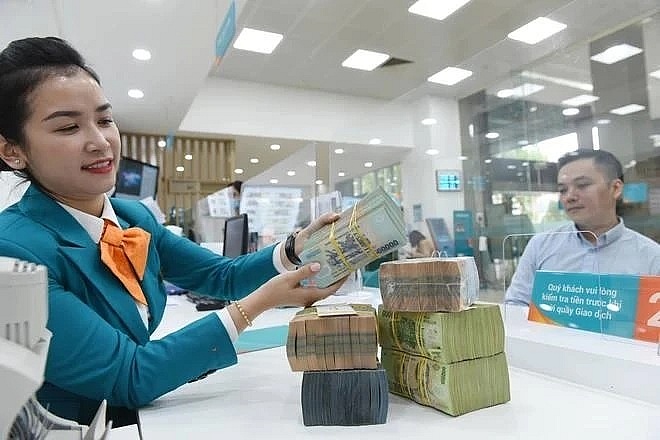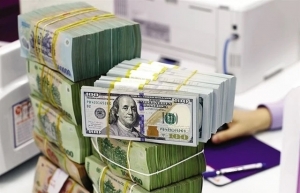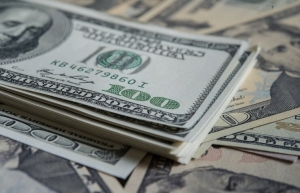Monetary policy flexible and stable
On the morning of October 24, the State Bank of Vietnam (SBV) announced a central exchange rate of VND24,250/USD, up VND10. This marked the eighth consecutive session with a rate increase. On the interbank market, the exchange rate closed at VND25,433/USD for the session, a rise of 0.91 per cent on-week and reflecting a 3.4 per cent increase.
 |
| Monetary policy flexible and stable, photo VNA |
“The sharp uptick in the exchange rate after a deep decline highlights the unpredictable risks that policymakers face in a volatile global landscape,” said Dr. Vo Tri Thanh, a member of the National Financial and Monetary Policy Advisory Council. “It is essential for the SBV to exercise caution, maintaining open-market operations to inject and withdraw liquidity rather than lowering key interest rates. The regulator must consider various contingencies to implement an adaptive policy response.”
In response to exchange rate pressures, the SBV has issued short-term treasury bills to absorb liquidity, raising interbank interest rates and narrowing the spread between VND and USD, indirectly supporting the exchange rate.
Following four consecutive sessions of treasury bill issuance, interbank interest rates have rebounded. By October 23, overnight VND rates were at 3.83 per cent, while the one-week rate reached 3.99 per cent, an increase of 1.1 per cent and 1.03 per cent from the previous week.
Looking ahead to the end of this year and into the next, the SBV should continue its prudent yet flexible monetary policy approach, he added. “By actively managing monetary tools, it can support economic growth, stabilise the macroeconomy, and balance exchange and interest rates at relatively stable levels. Though challenging, with experienced management, the SBV can achieve these goals,” said Thanh.
Phan Dung Khanh, investment advisory director at Maybank Investment Bank, commended the SBV’s effective exchange rate management. “Although the exchange rate has risen, the devaluation remains relatively minor compared to major global and regional currencies. Since the beginning of the year, businesses have rarely expressed concerns about exchange rate volatility, which has been maintained at a stable level,” Khanh said.
Balancing growth support with macroeconomic stability remains a complex task for the SBV in the coming period, despite favourable factors such as the US Fed’s rate cut and the potential for another reduction by year-end.
Additional support from major central banks, sustained monetary easing policies, a surge in remittances, increased exports, and foreign direct investment disbursement serve as vital exchange supply channels, enhancing the SBV’s ability to stabilise the exchange rate.
In a report presented to the National Assembly on October 22, SBV Governor Nguyen Thi Hong stated that it would continue to implement a flexible monetary policy in alignment with fiscal and other macroeconomic policies.
“The goal of upcoming monetary policy is to promote economic growth, control inflation, and stabilise the monetary and foreign exchange markets,” Hong said. “The SBV will proactively and flexibly operate open market activities to maintain liquidity for credit institutions, adjust interest rates in line with policy objectives, and encourage credit institutions to lower lending costs.”
| Ngo Dang Khoa, head, Markets and Securities HSBC Vietnam Data from the State Bank of Vietnam (SBV) shows credit growth outpacing deposit growth by 3.7 per cent, sparking concerns over potential liquidity strains. The overall trend of the interest rate in the past year is downward. Though this year’s credit growth is not at the level of previous years due to weaker borrowing demands, deposit growth is even low compared with credit growth. If credit growth increases during the last months of the year, banks may have to raise deposit rate to increase deposit. The lending rate will go up accordingly. Although certain industries or specific companies might secure more favourable interest rates, the overall lending rate landscape is unlikely to see much reduction, especially as funding costs rise. HSBC forecasts that the policy rate will remain unchanged into 2025, while market interest rates will stay quite stable, supported by the SBV with an aim to stabilise macro economy and support the economic recovery. Additionally, inflation managed to stay below the 4 per cent target, which is another factor that supports a stable interest rate.. The US Federal Reserve’s moves could impact Vietnam’s foreign exchange and interest rate policies. Earlier this year, the market expected the Fed to cut interest rates 11-12 times, but data released a few weeks ago has shifted these expectations. As of October 17, the DXY stood at 103.52 points, after having dipped to around 101 points just weeks ago, reflecting a 2-3 per cent increase. This indicates that the market is now anticipating rate cuts to be slower and less frequent than initially thought. For Vietnam’s foreign exchange market, it could fluctuate in the upcoming time. This follows world economic movements and DXY, which depend on the US economic indicators like inflation, employment, consumption but also the Fed’s decisions in next meetings. Additionally, the upcoming US election result could introduce further impacts on the financial markets and DXY. |
 | Central bank takes looser monetary measures The State Bank of Vietnam (SBV) has relaxed monetary measures in the context of sharp declines in the foreign exchange rate in recent days. |
 | Fed goes big with long-awaited cut The US Federal Reserve’s latest interest rate cut is expected to ease pressure on Vietnam’s exchange rates, support domestic monetary policy, and potentially reverse foreign capital outflows, benefiting the country’s stock market and general economy. |
 | Fed rate cut expands Vietnamese monetary policy flexibility The decision to cut interest rates by 50 basis-point in last week's Fed meeting is expected to have several positive impacts on the Vietnamese economy, specifically by alleviating exchange rate pressures and allowing the State Bank of Vietnam to implement a more accommodative monetary policy. |
What the stars mean:
★ Poor ★ ★ Promising ★★★ Good ★★★★ Very good ★★★★★ Exceptional
Related Contents
Latest News
More News
- Banks gear up for massive capital increases (December 18, 2025 | 17:04)
- Securing capital and efficiency for Vietnam’s 2026-2030 growth ambitions (December 17, 2025 | 10:00)
- Energy sector in need of blended finance mechanisms (December 17, 2025 | 09:00)
- Vietnam still has room to mobilise capital for sustainable growth (December 17, 2025 | 08:57)
- Long-term capital seen as key hurdle to green growth (December 16, 2025 | 08:00)
- Gold prices swing amid tax debate and import uncertainty (December 15, 2025 | 18:04)
- Agribank frames bank credit as catalyst for green growth (December 15, 2025 | 17:59)
- Vietnam’s green transition demands collective financial action (December 15, 2025 | 12:00)
- VIR workshop highlights capital and policy for sustainable development (December 15, 2025 | 11:00)
- Promoting digital assets initiative in Vietnam (December 13, 2025 | 09:30)

 Tag:
Tag:






















 Mobile Version
Mobile Version